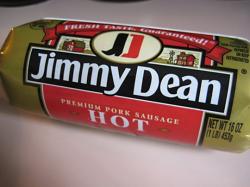Jimmy Dean & Hillshire Farm Brands Among Lead Sponsors of BlogHer ’10 Conference
August 5, 2010 | 3 min to read

DOWNERS GROVE, Ill. — Sara Lee North American Retail announced today that two of the company's iconic brands, Jimmy Dean and Hillshire Farm, will together serve as Diamond Sponsors at BlogHer '10, the pre-eminent annual conference for female bloggers. Currently in its sixth year, BlogHer '10 marks the first time that the conference is being held in New York with a record attendance of more than 2,400 anticipated to be at the sold-out event at the Hilton Hotel from August 6-7.
Jimmy Dean and Hillshire Farm will together host the largest space on the BlogHer trade show floor, an 80 foot by 20 foot kitchen-themed booth that will bring to life each of their unique brand personas. BlogHer will serve as a platform for Jimmy Dean and Hillshire Farm to interact directly with the 2,400 bloggers in attendance and unveil a number of exciting announcements from both brands including new product introductions and celebrity guest appearances. Among the activities, Hillshire Farm will team with Emmy nominated host of "Top Chef," Padma Lakshmi, to host a sandwich-making contest featuring the fresh taste of Hillshire Farm lunchmeat. Additionally, Jimmy Dean will provide bloggers with a chance to fuel their bodies with hearty and satisfying breakfast foods and an opportunity to meet The Jimmy Dean Sun.
"BlogHer is the leading conference for online female influencers and serves as a unique opportunity to engage face-to-face with virtually all of the top female bloggers, the voices that are driving the conversation and shaping the social media landscape. This event is the perfect platform to fuel brand awareness and further a dialogue among these critical audiences as well as gather valuable insights directly from the bloggers themselves. Additionally, we look forward to unveiling a number of exciting announcements from Jimmy Dean and Hillshire Farm," said Laston Charriez, vice president consumer and shopper activation at Sara Lee North American Retail.
About Jimmy Dean
Jimmy Dean is America's number one breakfast sausage. Since 1969, the brand has ensured quality in every plate of Jimmy Dean goodness that families can sit down to enjoy. The Jimmy Dean portfolio's full line of breakfast sausage, bacon and sandwiches gives families that delicious, home-cooked flavor. Jimmy Dean Fresh Roll Breakfast Sausage, Fresh Links & Patties, Fresh Bacon, Fully Cooked Sausage Links & Patties, Omelets, Skillets, Sandwiches, Breakfast Bowls, D-lights(R), Heat 'N Serve Sausage Links & Patties and Pancakes & Sausage on a Stick boast full flavors and top quality ingredients guaranteed to make any meal the best. Visit www.jimmydean.com for additional information.
About Hillshire Farm
Hillshire Farm has been providing quality meat products since 1934. Our products are versatile, easy to use and are available in convenient stay-fresh packaging in a variety of cuts, sizes and flavors. The Hillshire Farm portfolio of quality meats includes: Hillshire Farm Deli Select lunchmeats. Visit www.gomeat.com for additional information.
About Sara Lee Corporation
Each and every day, Sara Lee /quotes/comstock/13*!sle/quotes/nls/sle (SLE 15.00, -0.32, -2.08%) delights millions of consumers and customers around the world. The company has one of the world's best-loved and leading portfolios with its innovative and trusted food, beverage, household and body care brands, including Ball Park, Douwe Egberts, Hillshire Farm, Jimmy Dean, Kiwi, Sanex, Sara Lee and Senseo. Collectively, these brands generate almost $13 billion in annual net sales covering approximately 180 countries. The Sara Lee community consists of approximately 41,000 employees worldwide. Please visit http://www.saralee.com for the latest news and in-depth information about Sara Lee and its brands.
Source: Sara Lee Corporation
